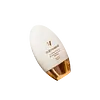Skincare by Dr V InZincable SPF 50 Versus Garnier Ambre Solaire Kids Sensitive Advanced Sun Cream Spray SPF 50+
What's inside
What's inside
 Key Ingredients
Key Ingredients

 Benefits
Benefits

 Concerns
Concerns

 Ingredients Side-by-side
Ingredients Side-by-side

Water
Skin ConditioningZinc Oxide 17%
Cosmetic ColorantC12-15 Alkyl Benzoate
AntimicrobialButyloctyl Salicylate
Skin ConditioningCaprylyl Methicone
Skin ConditioningGlycerin
HumectantDimethicone
EmollientNiacinamide
SmoothingCopernicia Cerifera Wax
Argania Spinosa Kernel Oil
EmollientTocopheryl Acetate
AntioxidantPEG-9 Polydimethylsiloxyethyl Dimethicone
EmulsifyingCapsicum Annuum Fruit Extract
AntimicrobialPolyhydroxystearic Acid
EmulsifyingDimethicone/PEG-10/15 Crosspolymer
Stearalkonium Hectorite
Gel FormingTocopherol
AntioxidantPhenoxyethanol
PreservativeSodium PCA
HumectantBuddleja Davidii Callus Extract
Dimethicone/Vinyl Dimethicone Crosspolymer
Skin ConditioningPropylene Carbonate
SolventIsostearic Acid
CleansingOryza Sativa Bran Wax
Skin ConditioningBisabolol
MaskingDisodium EDTA
Citric Acid
BufferingDipropylene Glycol
HumectantSodium Benzoate
MaskingXanthan Gum
EmulsifyingSodium Citrate
BufferingSodium Salicylate
PreservativeWater, Zinc Oxide 17%, C12-15 Alkyl Benzoate, Butyloctyl Salicylate, Caprylyl Methicone, Glycerin, Dimethicone, Niacinamide, Copernicia Cerifera Wax, Argania Spinosa Kernel Oil, Tocopheryl Acetate, PEG-9 Polydimethylsiloxyethyl Dimethicone, Capsicum Annuum Fruit Extract, Polyhydroxystearic Acid, Dimethicone/PEG-10/15 Crosspolymer, Stearalkonium Hectorite, Tocopherol, Phenoxyethanol, Sodium PCA, Buddleja Davidii Callus Extract, Dimethicone/Vinyl Dimethicone Crosspolymer, Propylene Carbonate, Isostearic Acid, Oryza Sativa Bran Wax, Bisabolol, Disodium EDTA, Citric Acid, Dipropylene Glycol, Sodium Benzoate, Xanthan Gum, Sodium Citrate, Sodium Salicylate
Water
Skin ConditioningDiethylamino Hydroxybenzoyl Hexyl Benzoate
UV FilterAlcohol Denat.
AntimicrobialHomosalate
Skin ConditioningEthylhexyl Salicylate
UV AbsorberButyl Methoxydibenzoylmethane
UV AbsorberOctocrylene
UV AbsorberGlycerin
HumectantPropanediol
SolventBis-Ethylhexyloxyphenol Methoxyphenyl Triazine
Skin ConditioningC12-22 Alkyl Acrylate/Hydroxyethylacrylate Copolymer
StabilisingDiisopropyl Adipate
EmollientDiisopropyl Sebacate
EmollientDicaprylyl Ether
EmollientEthylhexyl Triazone
UV AbsorberTocopherol
AntioxidantHydroxyacetophenone
AntioxidantSodium Polyacrylate
AbsorbentTrisodium Ethylenediamine Disuccinate
Triethanolamine
BufferingDrometrizole Trisiloxane
UV AbsorberAloe Barbadensis Leaf Juice Powder
Skin ConditioningCaprylyl Glycol
EmollientAcrylates/C10-30 Alkyl Acrylate Crosspolymer
Emulsion StabilisingWater, Diethylamino Hydroxybenzoyl Hexyl Benzoate, Alcohol Denat., Homosalate, Ethylhexyl Salicylate, Butyl Methoxydibenzoylmethane, Octocrylene, Glycerin, Propanediol, Bis-Ethylhexyloxyphenol Methoxyphenyl Triazine, C12-22 Alkyl Acrylate/Hydroxyethylacrylate Copolymer, Diisopropyl Adipate, Diisopropyl Sebacate, Dicaprylyl Ether, Ethylhexyl Triazone, Tocopherol, Hydroxyacetophenone, Sodium Polyacrylate, Trisodium Ethylenediamine Disuccinate, Triethanolamine, Drometrizole Trisiloxane, Aloe Barbadensis Leaf Juice Powder, Caprylyl Glycol, Acrylates/C10-30 Alkyl Acrylate Crosspolymer
Ingredients Explained
These ingredients are found in both products.
Ingredients higher up in an ingredient list are typically present in a larger amount.
Glycerin is already naturally found in your skin. It helps moisturize and protect your skin.
A study from 2016 found glycerin to be more effective as a humectant than AHAs and hyaluronic acid.
As a humectant, it helps the skin stay hydrated by pulling moisture to your skin. The low molecular weight of glycerin allows it to pull moisture into the deeper layers of your skin.
Hydrated skin improves your skin barrier; Your skin barrier helps protect against irritants and bacteria.
Glycerin has also been found to have antimicrobial and antiviral properties. Due to these properties, glycerin is often used in wound and burn treatments.
In cosmetics, glycerin is usually derived from plants such as soybean or palm. However, it can also be sourced from animals, such as tallow or animal fat.
This ingredient is organic, colorless, odorless, and non-toxic.
Glycerin is the name for this ingredient in American English. British English uses Glycerol/Glycerine.
Learn more about GlycerinTocopherol (also known as Vitamin E) is a common antioxidant used to help protect the skin from free-radicals and strengthen the skin barrier. It's also fat soluble - this means our skin is great at absorbing it.
Vitamin E also helps keep your natural skin lipids healthy. Your lipid skin barrier naturally consists of lipids, ceramides, and fatty acids. Vitamin E offers extra protection for your skin’s lipid barrier, keeping your skin healthy and nourished.
Another benefit is a bit of UV protection. Vitamin E helps reduce the damage caused by UVB rays. (It should not replace your sunscreen). Combining it with Vitamin C can decrease sunburned cells and hyperpigmentation after UV exposure.
You might have noticed Vitamin E + C often paired together. This is because it is great at stabilizing Vitamin C. Using the two together helps increase the effectiveness of both ingredients.
There are often claims that Vitamin E can reduce/prevent scarring, but these claims haven't been confirmed by scientific research.
Learn more about TocopherolWater. It's the most common cosmetic ingredient of all. You'll usually see it at the top of ingredient lists, meaning that it makes up the largest part of the product.
So why is it so popular? Water most often acts as a solvent - this means that it helps dissolve other ingredients into the formulation.
You'll also recognize water as that liquid we all need to stay alive. If you see this, drink a glass of water. Stay hydrated!
Learn more about Water